HI5017 Management Accounting Case Studies: Cost Analysis & Critique
VerifiedAdded on 2023/03/31
|11
|3347
|500
Case Study
AI Summary
This assignment presents a comprehensive analysis of a management accounting case study, focusing on cost concepts, relevant vs. irrelevant costs, and incremental cash flow analysis. It evaluates different alternatives for decision-making and provides a recommendation letter based on the analysis. Additionally, it includes a critique of a journal article, examining the role of managerial accounting in innovation management, specifically referencing Canon, Inc. and Apple Computer, Inc. The analysis covers the application of managerial accounting tools and techniques in enhancing decision-making processes and achieving business success. The assignment concludes by highlighting the importance of information sharing and collaboration in developing innovative products and ensuring cost-effectiveness.
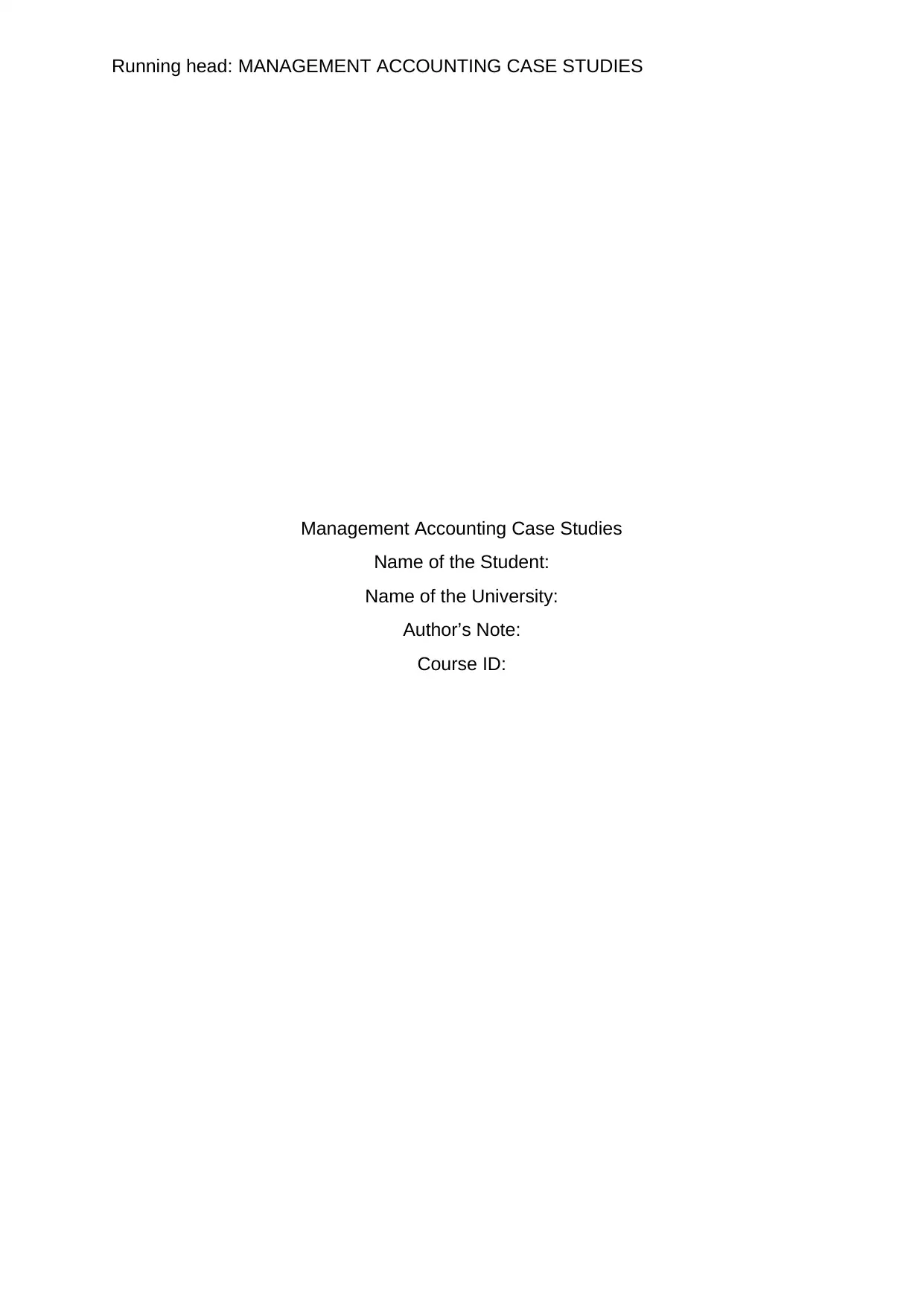
Running head: MANAGEMENT ACCOUNTING CASE STUDIES
Management Accounting Case Studies
Name of the Student:
Name of the University:
Author’s Note:
Course ID:
Management Accounting Case Studies
Name of the Student:
Name of the University:
Author’s Note:
Course ID:
Paraphrase This Document
Need a fresh take? Get an instant paraphrase of this document with our AI Paraphraser
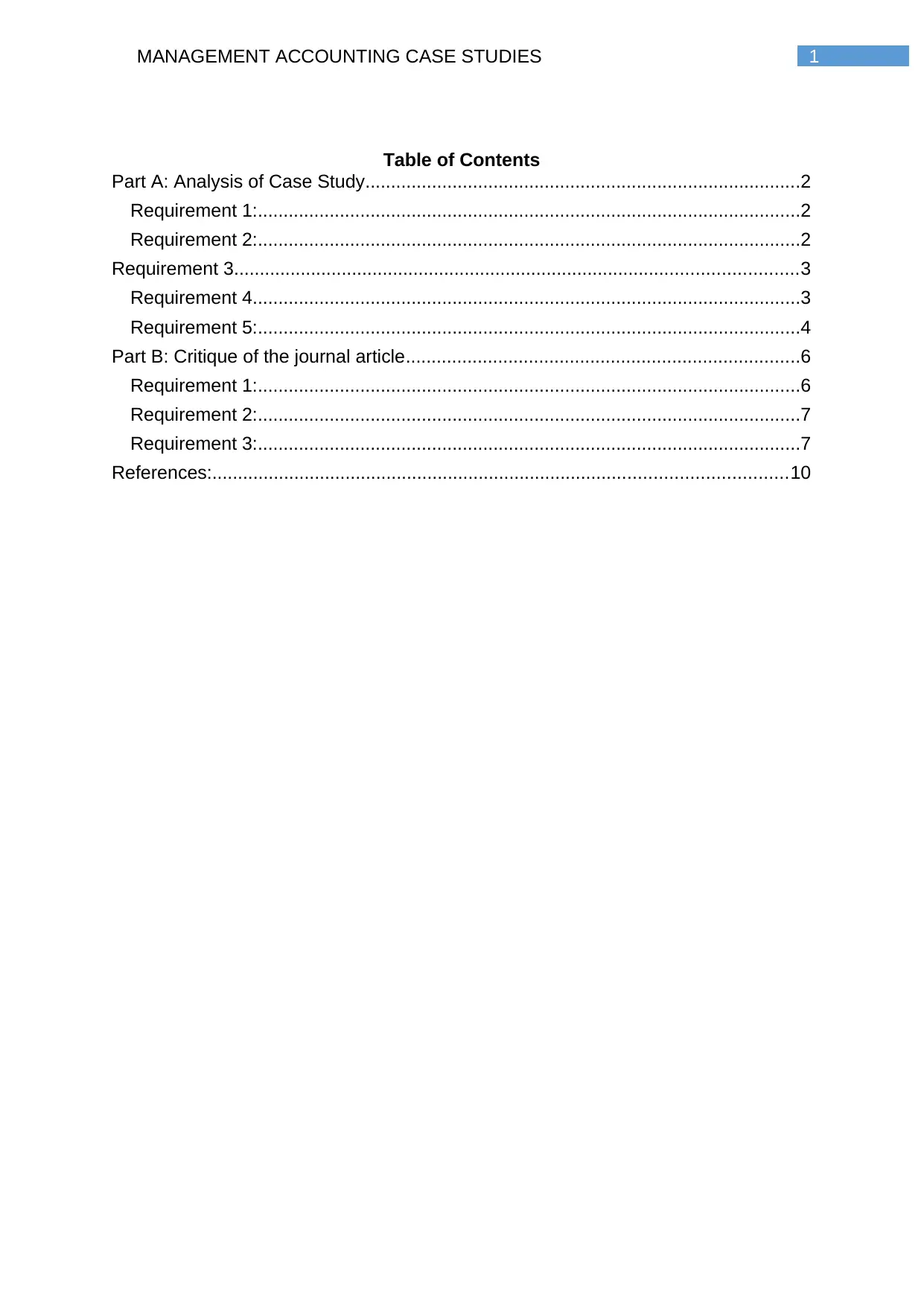
1MANAGEMENT ACCOUNTING CASE STUDIES
Table of Contents
Part A: Analysis of Case Study.....................................................................................2
Requirement 1:..........................................................................................................2
Requirement 2:..........................................................................................................2
Requirement 3..............................................................................................................3
Requirement 4...........................................................................................................3
Requirement 5:..........................................................................................................4
Part B: Critique of the journal article.............................................................................6
Requirement 1:..........................................................................................................6
Requirement 2:..........................................................................................................7
Requirement 3:..........................................................................................................7
References:................................................................................................................10
Table of Contents
Part A: Analysis of Case Study.....................................................................................2
Requirement 1:..........................................................................................................2
Requirement 2:..........................................................................................................2
Requirement 3..............................................................................................................3
Requirement 4...........................................................................................................3
Requirement 5:..........................................................................................................4
Part B: Critique of the journal article.............................................................................6
Requirement 1:..........................................................................................................6
Requirement 2:..........................................................................................................7
Requirement 3:..........................................................................................................7
References:................................................................................................................10
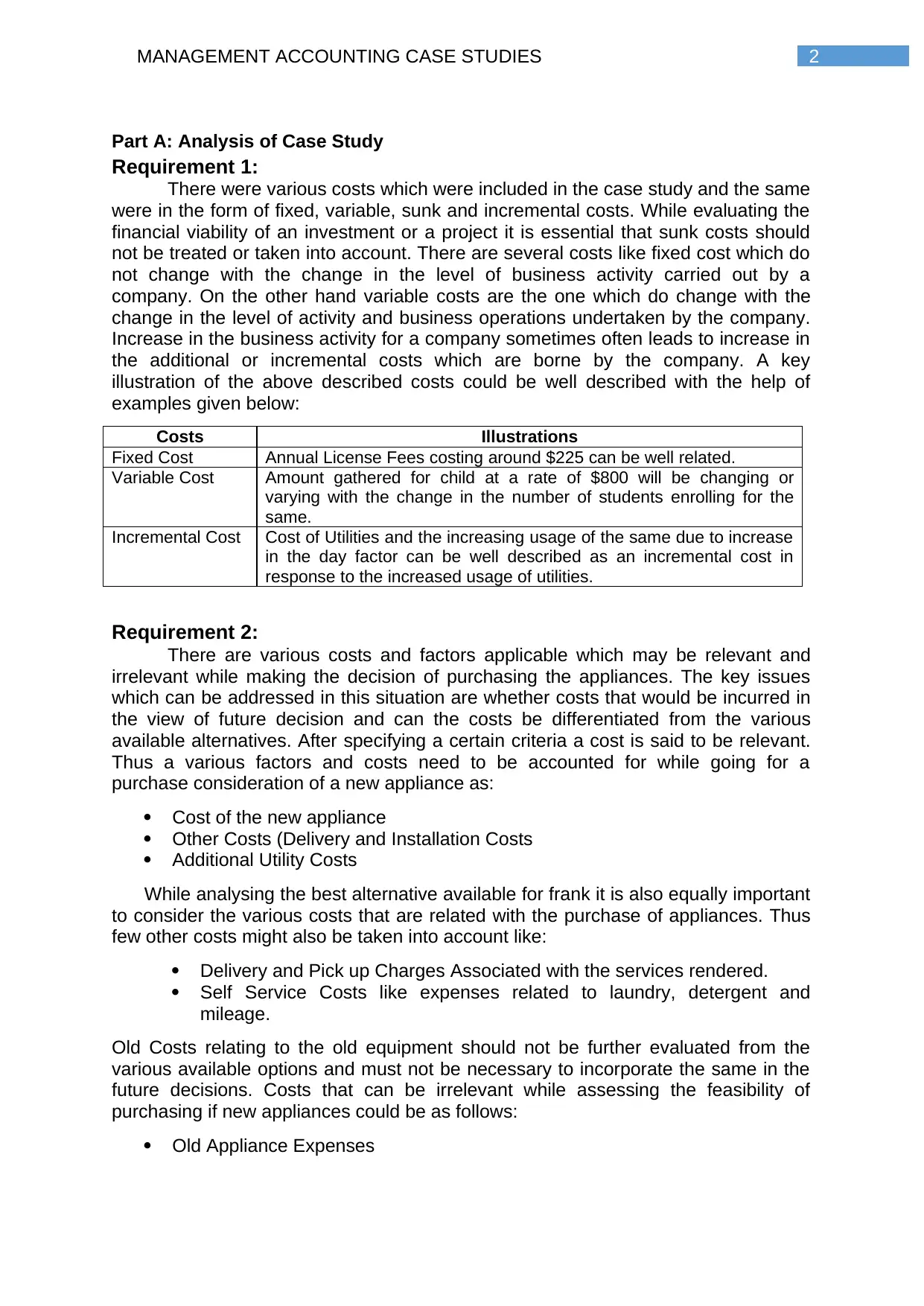
2MANAGEMENT ACCOUNTING CASE STUDIES
Part A: Analysis of Case Study
Requirement 1:
There were various costs which were included in the case study and the same
were in the form of fixed, variable, sunk and incremental costs. While evaluating the
financial viability of an investment or a project it is essential that sunk costs should
not be treated or taken into account. There are several costs like fixed cost which do
not change with the change in the level of business activity carried out by a
company. On the other hand variable costs are the one which do change with the
change in the level of activity and business operations undertaken by the company.
Increase in the business activity for a company sometimes often leads to increase in
the additional or incremental costs which are borne by the company. A key
illustration of the above described costs could be well described with the help of
examples given below:
Costs Illustrations
Fixed Cost Annual License Fees costing around $225 can be well related.
Variable Cost Amount gathered for child at a rate of $800 will be changing or
varying with the change in the number of students enrolling for the
same.
Incremental Cost Cost of Utilities and the increasing usage of the same due to increase
in the day factor can be well described as an incremental cost in
response to the increased usage of utilities.
Requirement 2:
There are various costs and factors applicable which may be relevant and
irrelevant while making the decision of purchasing the appliances. The key issues
which can be addressed in this situation are whether costs that would be incurred in
the view of future decision and can the costs be differentiated from the various
available alternatives. After specifying a certain criteria a cost is said to be relevant.
Thus a various factors and costs need to be accounted for while going for a
purchase consideration of a new appliance as:
Cost of the new appliance
Other Costs (Delivery and Installation Costs
Additional Utility Costs
While analysing the best alternative available for frank it is also equally important
to consider the various costs that are related with the purchase of appliances. Thus
few other costs might also be taken into account like:
Delivery and Pick up Charges Associated with the services rendered.
Self Service Costs like expenses related to laundry, detergent and
mileage.
Old Costs relating to the old equipment should not be further evaluated from the
various available options and must not be necessary to incorporate the same in the
future decisions. Costs that can be irrelevant while assessing the feasibility of
purchasing if new appliances could be as follows:
Old Appliance Expenses
Part A: Analysis of Case Study
Requirement 1:
There were various costs which were included in the case study and the same
were in the form of fixed, variable, sunk and incremental costs. While evaluating the
financial viability of an investment or a project it is essential that sunk costs should
not be treated or taken into account. There are several costs like fixed cost which do
not change with the change in the level of business activity carried out by a
company. On the other hand variable costs are the one which do change with the
change in the level of activity and business operations undertaken by the company.
Increase in the business activity for a company sometimes often leads to increase in
the additional or incremental costs which are borne by the company. A key
illustration of the above described costs could be well described with the help of
examples given below:
Costs Illustrations
Fixed Cost Annual License Fees costing around $225 can be well related.
Variable Cost Amount gathered for child at a rate of $800 will be changing or
varying with the change in the number of students enrolling for the
same.
Incremental Cost Cost of Utilities and the increasing usage of the same due to increase
in the day factor can be well described as an incremental cost in
response to the increased usage of utilities.
Requirement 2:
There are various costs and factors applicable which may be relevant and
irrelevant while making the decision of purchasing the appliances. The key issues
which can be addressed in this situation are whether costs that would be incurred in
the view of future decision and can the costs be differentiated from the various
available alternatives. After specifying a certain criteria a cost is said to be relevant.
Thus a various factors and costs need to be accounted for while going for a
purchase consideration of a new appliance as:
Cost of the new appliance
Other Costs (Delivery and Installation Costs
Additional Utility Costs
While analysing the best alternative available for frank it is also equally important
to consider the various costs that are related with the purchase of appliances. Thus
few other costs might also be taken into account like:
Delivery and Pick up Charges Associated with the services rendered.
Self Service Costs like expenses related to laundry, detergent and
mileage.
Old Costs relating to the old equipment should not be further evaluated from the
various available options and must not be necessary to incorporate the same in the
future decisions. Costs that can be irrelevant while assessing the feasibility of
purchasing if new appliances could be as follows:
Old Appliance Expenses
⊘ This is a preview!⊘
Do you want full access?
Subscribe today to unlock all pages.

Trusted by 1+ million students worldwide
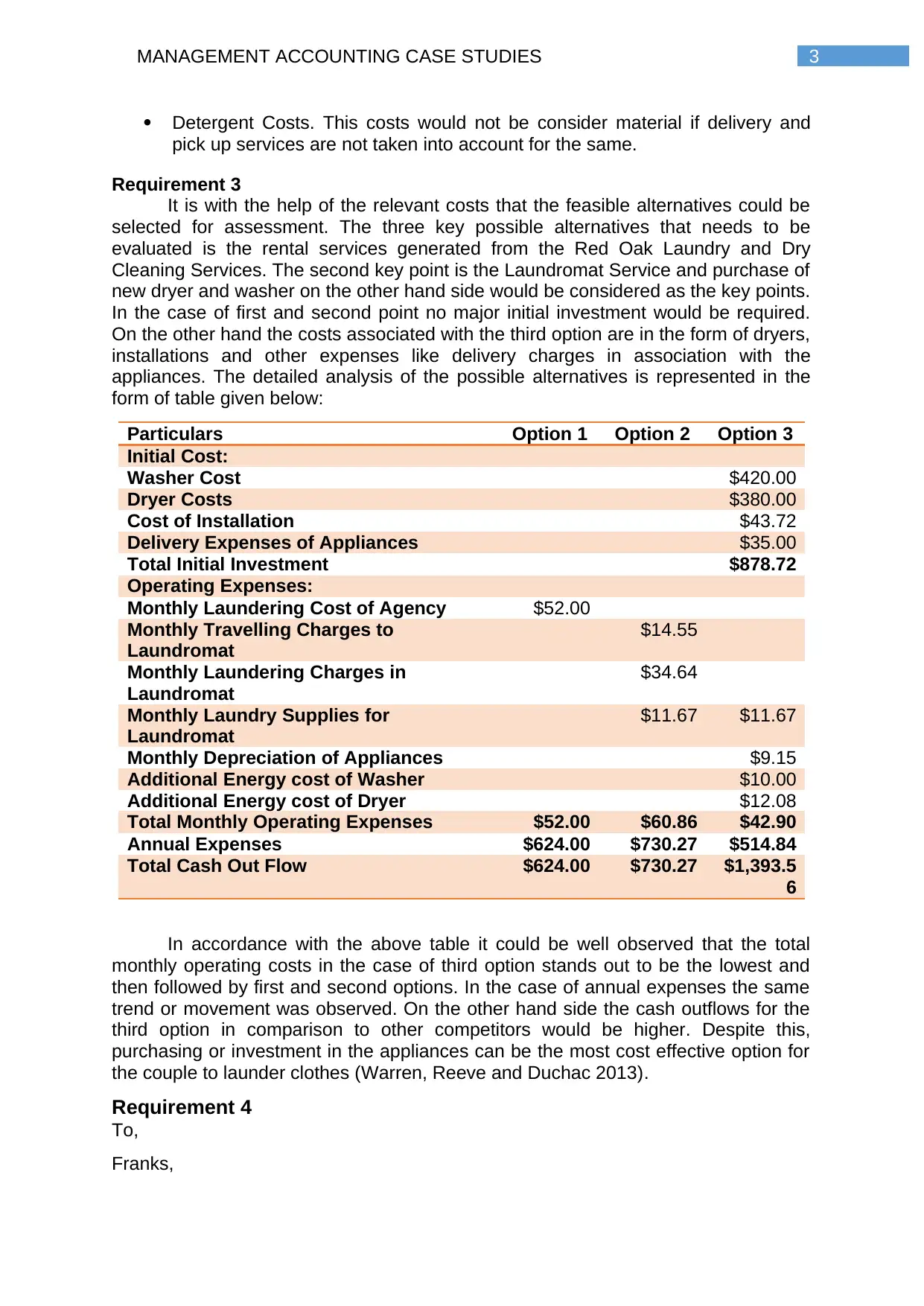
3MANAGEMENT ACCOUNTING CASE STUDIES
Detergent Costs. This costs would not be consider material if delivery and
pick up services are not taken into account for the same.
Requirement 3
It is with the help of the relevant costs that the feasible alternatives could be
selected for assessment. The three key possible alternatives that needs to be
evaluated is the rental services generated from the Red Oak Laundry and Dry
Cleaning Services. The second key point is the Laundromat Service and purchase of
new dryer and washer on the other hand side would be considered as the key points.
In the case of first and second point no major initial investment would be required.
On the other hand the costs associated with the third option are in the form of dryers,
installations and other expenses like delivery charges in association with the
appliances. The detailed analysis of the possible alternatives is represented in the
form of table given below:
Particulars Option 1 Option 2 Option 3
Initial Cost:
Washer Cost $420.00
Dryer Costs $380.00
Cost of Installation $43.72
Delivery Expenses of Appliances $35.00
Total Initial Investment $878.72
Operating Expenses:
Monthly Laundering Cost of Agency $52.00
Monthly Travelling Charges to
Laundromat
$14.55
Monthly Laundering Charges in
Laundromat
$34.64
Monthly Laundry Supplies for
Laundromat
$11.67 $11.67
Monthly Depreciation of Appliances $9.15
Additional Energy cost of Washer $10.00
Additional Energy cost of Dryer $12.08
Total Monthly Operating Expenses $52.00 $60.86 $42.90
Annual Expenses $624.00 $730.27 $514.84
Total Cash Out Flow $624.00 $730.27 $1,393.5
6
In accordance with the above table it could be well observed that the total
monthly operating costs in the case of third option stands out to be the lowest and
then followed by first and second options. In the case of annual expenses the same
trend or movement was observed. On the other hand side the cash outflows for the
third option in comparison to other competitors would be higher. Despite this,
purchasing or investment in the appliances can be the most cost effective option for
the couple to launder clothes (Warren, Reeve and Duchac 2013).
Requirement 4
To,
Franks,
Detergent Costs. This costs would not be consider material if delivery and
pick up services are not taken into account for the same.
Requirement 3
It is with the help of the relevant costs that the feasible alternatives could be
selected for assessment. The three key possible alternatives that needs to be
evaluated is the rental services generated from the Red Oak Laundry and Dry
Cleaning Services. The second key point is the Laundromat Service and purchase of
new dryer and washer on the other hand side would be considered as the key points.
In the case of first and second point no major initial investment would be required.
On the other hand the costs associated with the third option are in the form of dryers,
installations and other expenses like delivery charges in association with the
appliances. The detailed analysis of the possible alternatives is represented in the
form of table given below:
Particulars Option 1 Option 2 Option 3
Initial Cost:
Washer Cost $420.00
Dryer Costs $380.00
Cost of Installation $43.72
Delivery Expenses of Appliances $35.00
Total Initial Investment $878.72
Operating Expenses:
Monthly Laundering Cost of Agency $52.00
Monthly Travelling Charges to
Laundromat
$14.55
Monthly Laundering Charges in
Laundromat
$34.64
Monthly Laundry Supplies for
Laundromat
$11.67 $11.67
Monthly Depreciation of Appliances $9.15
Additional Energy cost of Washer $10.00
Additional Energy cost of Dryer $12.08
Total Monthly Operating Expenses $52.00 $60.86 $42.90
Annual Expenses $624.00 $730.27 $514.84
Total Cash Out Flow $624.00 $730.27 $1,393.5
6
In accordance with the above table it could be well observed that the total
monthly operating costs in the case of third option stands out to be the lowest and
then followed by first and second options. In the case of annual expenses the same
trend or movement was observed. On the other hand side the cash outflows for the
third option in comparison to other competitors would be higher. Despite this,
purchasing or investment in the appliances can be the most cost effective option for
the couple to launder clothes (Warren, Reeve and Duchac 2013).
Requirement 4
To,
Franks,
Paraphrase This Document
Need a fresh take? Get an instant paraphrase of this document with our AI Paraphraser
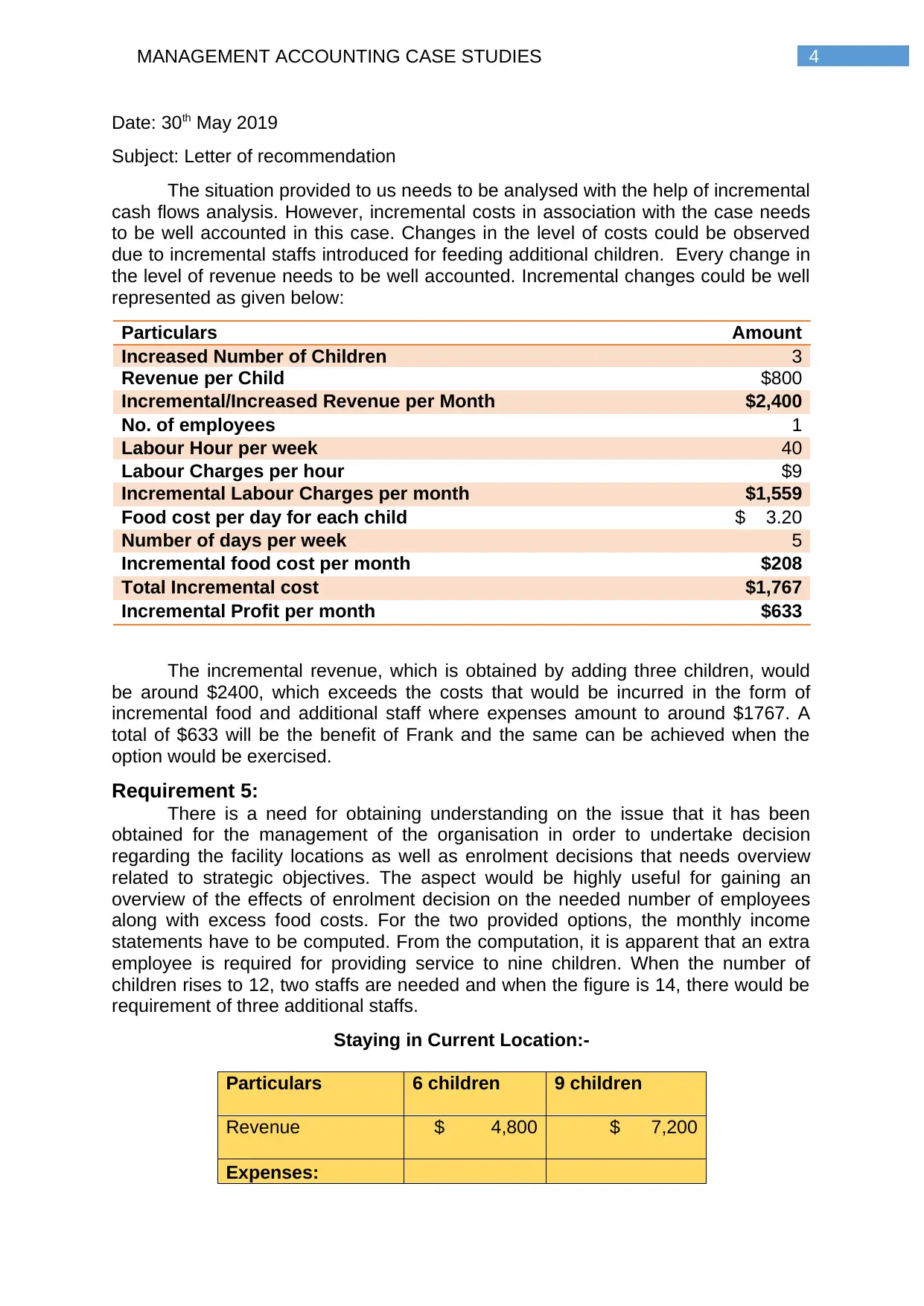
4MANAGEMENT ACCOUNTING CASE STUDIES
Date: 30th May 2019
Subject: Letter of recommendation
The situation provided to us needs to be analysed with the help of incremental
cash flows analysis. However, incremental costs in association with the case needs
to be well accounted in this case. Changes in the level of costs could be observed
due to incremental staffs introduced for feeding additional children. Every change in
the level of revenue needs to be well accounted. Incremental changes could be well
represented as given below:
Particulars Amount
Increased Number of Children 3
Revenue per Child $800
Incremental/Increased Revenue per Month $2,400
No. of employees 1
Labour Hour per week 40
Labour Charges per hour $9
Incremental Labour Charges per month $1,559
Food cost per day for each child $ 3.20
Number of days per week 5
Incremental food cost per month $208
Total Incremental cost $1,767
Incremental Profit per month $633
The incremental revenue, which is obtained by adding three children, would
be around $2400, which exceeds the costs that would be incurred in the form of
incremental food and additional staff where expenses amount to around $1767. A
total of $633 will be the benefit of Frank and the same can be achieved when the
option would be exercised.
Requirement 5:
There is a need for obtaining understanding on the issue that it has been
obtained for the management of the organisation in order to undertake decision
regarding the facility locations as well as enrolment decisions that needs overview
related to strategic objectives. The aspect would be highly useful for gaining an
overview of the effects of enrolment decision on the needed number of employees
along with excess food costs. For the two provided options, the monthly income
statements have to be computed. From the computation, it is apparent that an extra
employee is required for providing service to nine children. When the number of
children rises to 12, two staffs are needed and when the figure is 14, there would be
requirement of three additional staffs.
Staying in Current Location:-
Particulars 6 children 9 children
Revenue $ 4,800 $ 7,200
Expenses:
Date: 30th May 2019
Subject: Letter of recommendation
The situation provided to us needs to be analysed with the help of incremental
cash flows analysis. However, incremental costs in association with the case needs
to be well accounted in this case. Changes in the level of costs could be observed
due to incremental staffs introduced for feeding additional children. Every change in
the level of revenue needs to be well accounted. Incremental changes could be well
represented as given below:
Particulars Amount
Increased Number of Children 3
Revenue per Child $800
Incremental/Increased Revenue per Month $2,400
No. of employees 1
Labour Hour per week 40
Labour Charges per hour $9
Incremental Labour Charges per month $1,559
Food cost per day for each child $ 3.20
Number of days per week 5
Incremental food cost per month $208
Total Incremental cost $1,767
Incremental Profit per month $633
The incremental revenue, which is obtained by adding three children, would
be around $2400, which exceeds the costs that would be incurred in the form of
incremental food and additional staff where expenses amount to around $1767. A
total of $633 will be the benefit of Frank and the same can be achieved when the
option would be exercised.
Requirement 5:
There is a need for obtaining understanding on the issue that it has been
obtained for the management of the organisation in order to undertake decision
regarding the facility locations as well as enrolment decisions that needs overview
related to strategic objectives. The aspect would be highly useful for gaining an
overview of the effects of enrolment decision on the needed number of employees
along with excess food costs. For the two provided options, the monthly income
statements have to be computed. From the computation, it is apparent that an extra
employee is required for providing service to nine children. When the number of
children rises to 12, two staffs are needed and when the figure is 14, there would be
requirement of three additional staffs.
Staying in Current Location:-
Particulars 6 children 9 children
Revenue $ 4,800 $ 7,200
Expenses:
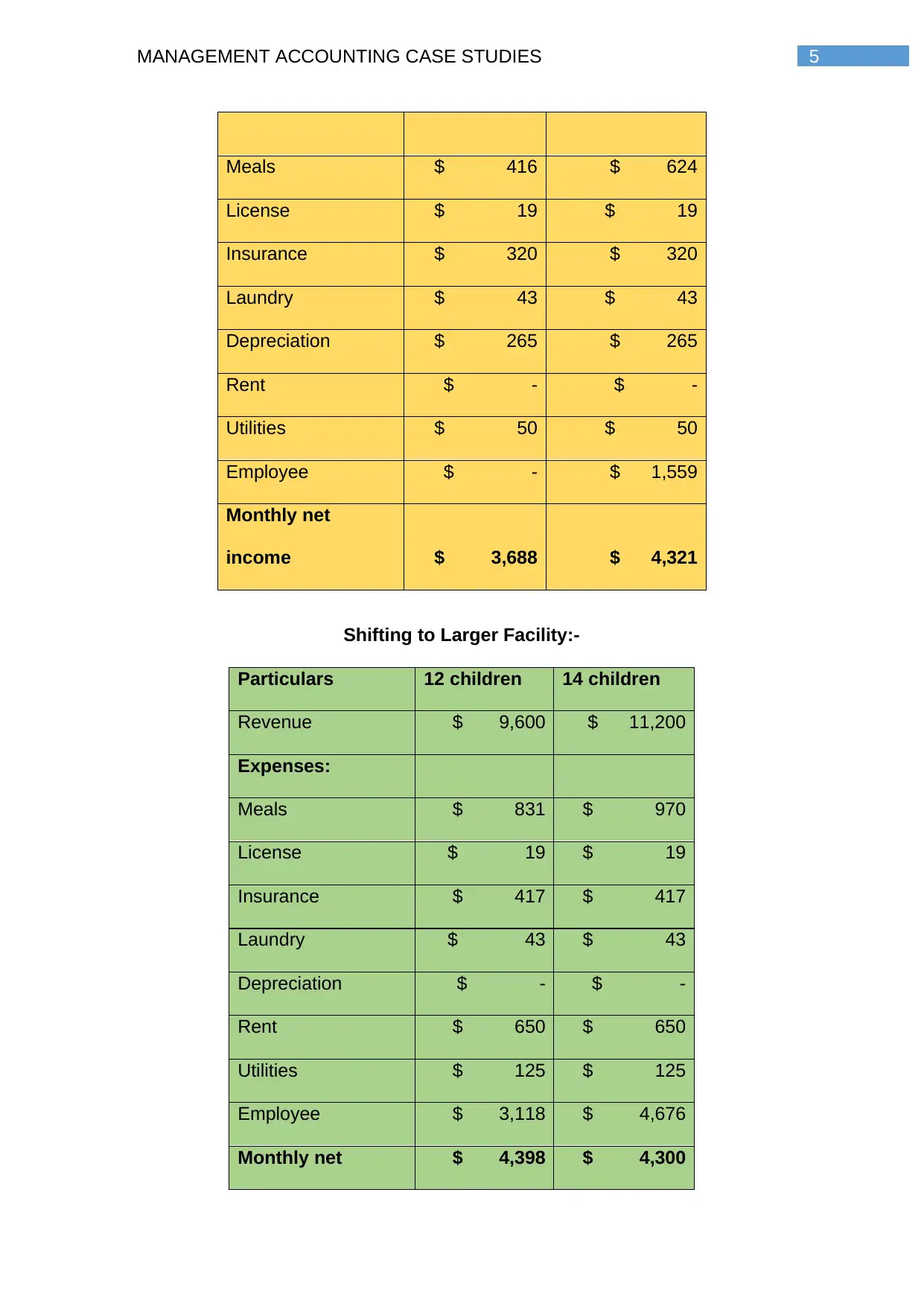
5MANAGEMENT ACCOUNTING CASE STUDIES
Meals $ 416 $ 624
License $ 19 $ 19
Insurance $ 320 $ 320
Laundry $ 43 $ 43
Depreciation $ 265 $ 265
Rent $ - $ -
Utilities $ 50 $ 50
Employee $ - $ 1,559
Monthly net
income $ 3,688 $ 4,321
Shifting to Larger Facility:-
Particulars 12 children 14 children
Revenue $ 9,600 $ 11,200
Expenses:
Meals $ 831 $ 970
License $ 19 $ 19
Insurance $ 417 $ 417
Laundry $ 43 $ 43
Depreciation $ - $ -
Rent $ 650 $ 650
Utilities $ 125 $ 125
Employee $ 3,118 $ 4,676
Monthly net $ 4,398 $ 4,300
Meals $ 416 $ 624
License $ 19 $ 19
Insurance $ 320 $ 320
Laundry $ 43 $ 43
Depreciation $ 265 $ 265
Rent $ - $ -
Utilities $ 50 $ 50
Employee $ - $ 1,559
Monthly net
income $ 3,688 $ 4,321
Shifting to Larger Facility:-
Particulars 12 children 14 children
Revenue $ 9,600 $ 11,200
Expenses:
Meals $ 831 $ 970
License $ 19 $ 19
Insurance $ 417 $ 417
Laundry $ 43 $ 43
Depreciation $ - $ -
Rent $ 650 $ 650
Utilities $ 125 $ 125
Employee $ 3,118 $ 4,676
Monthly net $ 4,398 $ 4,300
⊘ This is a preview!⊘
Do you want full access?
Subscribe today to unlock all pages.

Trusted by 1+ million students worldwide
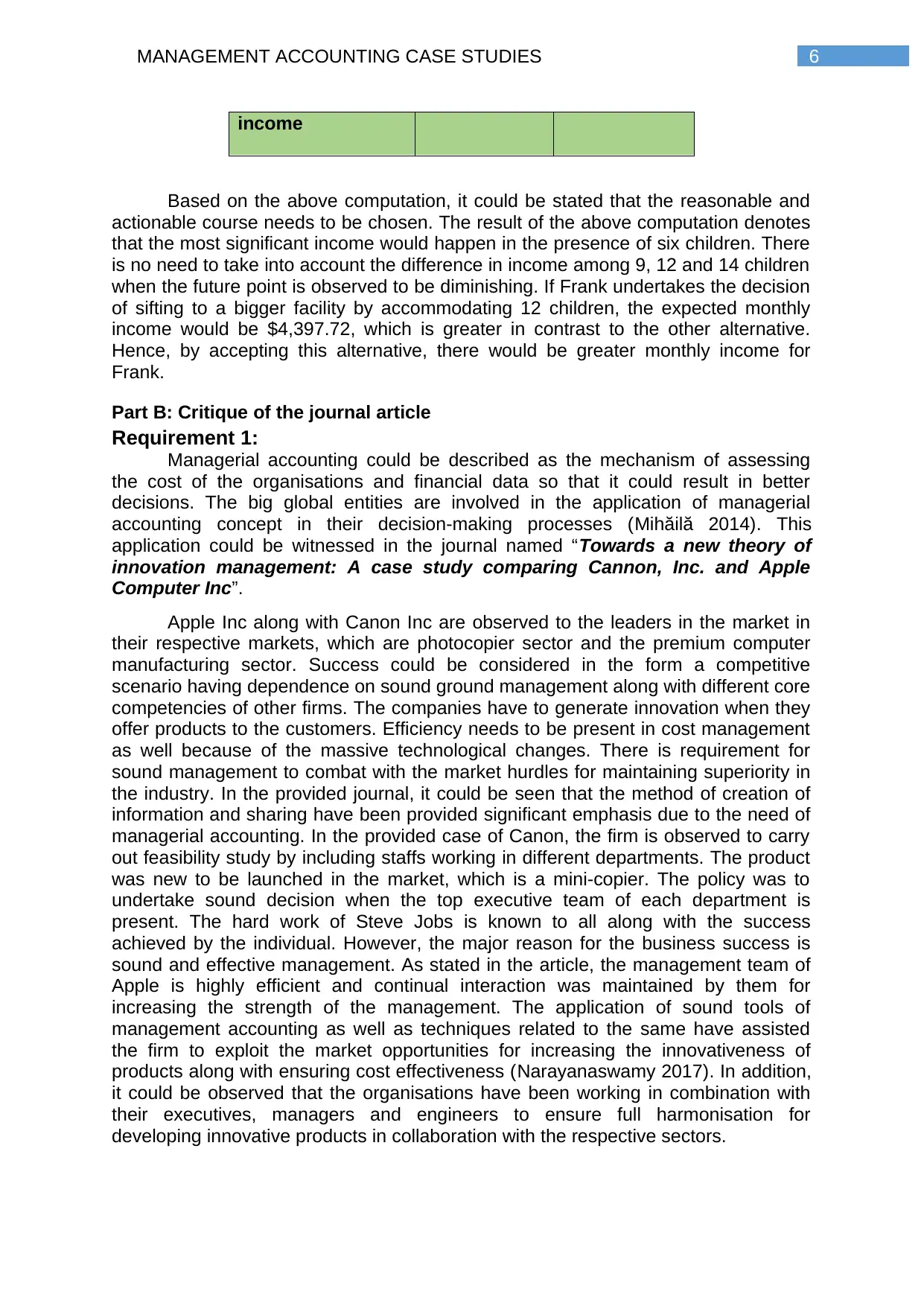
6MANAGEMENT ACCOUNTING CASE STUDIES
income
Based on the above computation, it could be stated that the reasonable and
actionable course needs to be chosen. The result of the above computation denotes
that the most significant income would happen in the presence of six children. There
is no need to take into account the difference in income among 9, 12 and 14 children
when the future point is observed to be diminishing. If Frank undertakes the decision
of sifting to a bigger facility by accommodating 12 children, the expected monthly
income would be $4,397.72, which is greater in contrast to the other alternative.
Hence, by accepting this alternative, there would be greater monthly income for
Frank.
Part B: Critique of the journal article
Requirement 1:
Managerial accounting could be described as the mechanism of assessing
the cost of the organisations and financial data so that it could result in better
decisions. The big global entities are involved in the application of managerial
accounting concept in their decision-making processes (Mihăilă 2014). This
application could be witnessed in the journal named “Towards a new theory of
innovation management: A case study comparing Cannon, Inc. and Apple
Computer Inc”.
Apple Inc along with Canon Inc are observed to the leaders in the market in
their respective markets, which are photocopier sector and the premium computer
manufacturing sector. Success could be considered in the form a competitive
scenario having dependence on sound ground management along with different core
competencies of other firms. The companies have to generate innovation when they
offer products to the customers. Efficiency needs to be present in cost management
as well because of the massive technological changes. There is requirement for
sound management to combat with the market hurdles for maintaining superiority in
the industry. In the provided journal, it could be seen that the method of creation of
information and sharing have been provided significant emphasis due to the need of
managerial accounting. In the provided case of Canon, the firm is observed to carry
out feasibility study by including staffs working in different departments. The product
was new to be launched in the market, which is a mini-copier. The policy was to
undertake sound decision when the top executive team of each department is
present. The hard work of Steve Jobs is known to all along with the success
achieved by the individual. However, the major reason for the business success is
sound and effective management. As stated in the article, the management team of
Apple is highly efficient and continual interaction was maintained by them for
increasing the strength of the management. The application of sound tools of
management accounting as well as techniques related to the same have assisted
the firm to exploit the market opportunities for increasing the innovativeness of
products along with ensuring cost effectiveness (Narayanaswamy 2017). In addition,
it could be observed that the organisations have been working in combination with
their executives, managers and engineers to ensure full harmonisation for
developing innovative products in collaboration with the respective sectors.
income
Based on the above computation, it could be stated that the reasonable and
actionable course needs to be chosen. The result of the above computation denotes
that the most significant income would happen in the presence of six children. There
is no need to take into account the difference in income among 9, 12 and 14 children
when the future point is observed to be diminishing. If Frank undertakes the decision
of sifting to a bigger facility by accommodating 12 children, the expected monthly
income would be $4,397.72, which is greater in contrast to the other alternative.
Hence, by accepting this alternative, there would be greater monthly income for
Frank.
Part B: Critique of the journal article
Requirement 1:
Managerial accounting could be described as the mechanism of assessing
the cost of the organisations and financial data so that it could result in better
decisions. The big global entities are involved in the application of managerial
accounting concept in their decision-making processes (Mihăilă 2014). This
application could be witnessed in the journal named “Towards a new theory of
innovation management: A case study comparing Cannon, Inc. and Apple
Computer Inc”.
Apple Inc along with Canon Inc are observed to the leaders in the market in
their respective markets, which are photocopier sector and the premium computer
manufacturing sector. Success could be considered in the form a competitive
scenario having dependence on sound ground management along with different core
competencies of other firms. The companies have to generate innovation when they
offer products to the customers. Efficiency needs to be present in cost management
as well because of the massive technological changes. There is requirement for
sound management to combat with the market hurdles for maintaining superiority in
the industry. In the provided journal, it could be seen that the method of creation of
information and sharing have been provided significant emphasis due to the need of
managerial accounting. In the provided case of Canon, the firm is observed to carry
out feasibility study by including staffs working in different departments. The product
was new to be launched in the market, which is a mini-copier. The policy was to
undertake sound decision when the top executive team of each department is
present. The hard work of Steve Jobs is known to all along with the success
achieved by the individual. However, the major reason for the business success is
sound and effective management. As stated in the article, the management team of
Apple is highly efficient and continual interaction was maintained by them for
increasing the strength of the management. The application of sound tools of
management accounting as well as techniques related to the same have assisted
the firm to exploit the market opportunities for increasing the innovativeness of
products along with ensuring cost effectiveness (Narayanaswamy 2017). In addition,
it could be observed that the organisations have been working in combination with
their executives, managers and engineers to ensure full harmonisation for
developing innovative products in collaboration with the respective sectors.
Paraphrase This Document
Need a fresh take? Get an instant paraphrase of this document with our AI Paraphraser
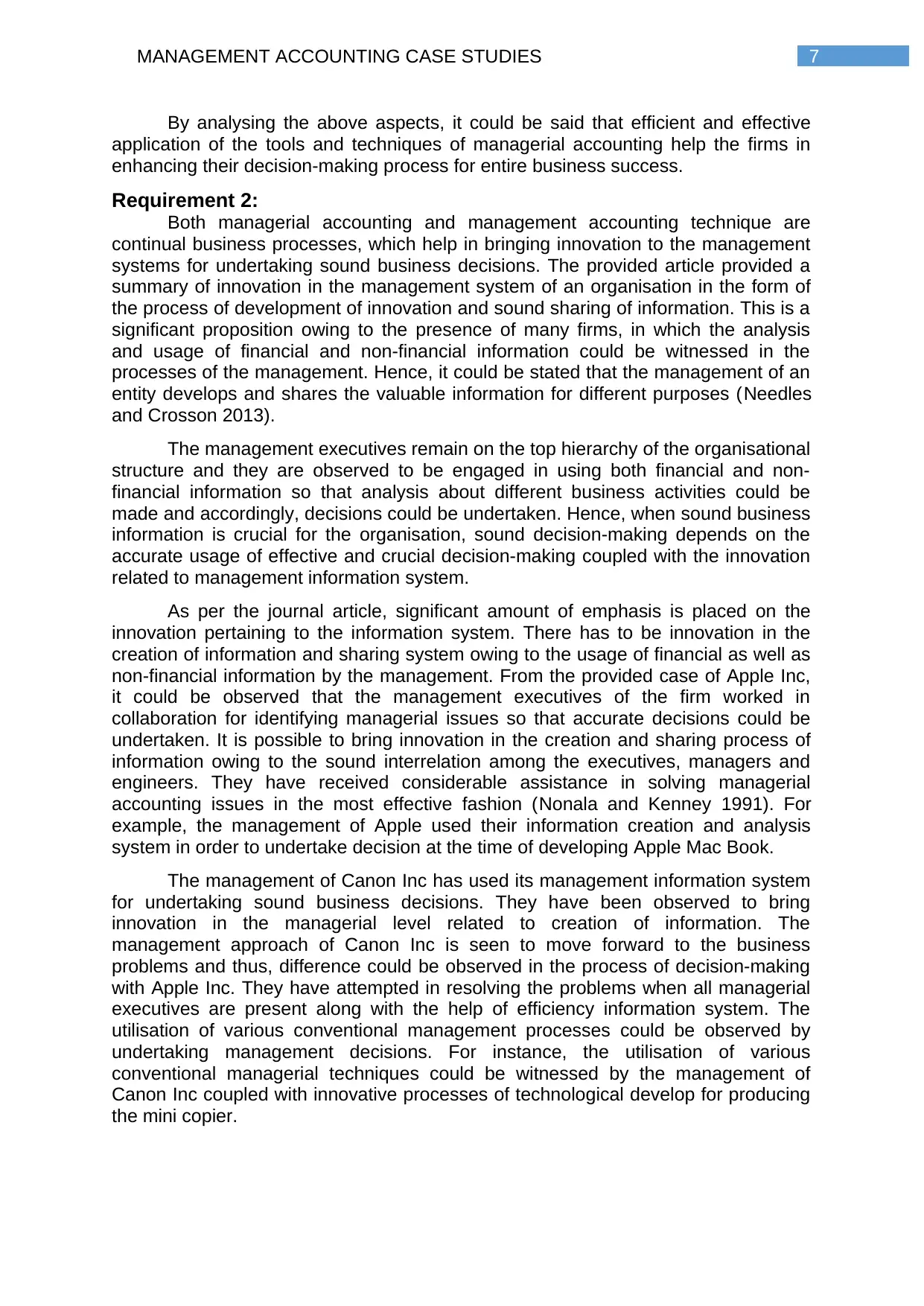
7MANAGEMENT ACCOUNTING CASE STUDIES
By analysing the above aspects, it could be said that efficient and effective
application of the tools and techniques of managerial accounting help the firms in
enhancing their decision-making process for entire business success.
Requirement 2:
Both managerial accounting and management accounting technique are
continual business processes, which help in bringing innovation to the management
systems for undertaking sound business decisions. The provided article provided a
summary of innovation in the management system of an organisation in the form of
the process of development of innovation and sound sharing of information. This is a
significant proposition owing to the presence of many firms, in which the analysis
and usage of financial and non-financial information could be witnessed in the
processes of the management. Hence, it could be stated that the management of an
entity develops and shares the valuable information for different purposes (Needles
and Crosson 2013).
The management executives remain on the top hierarchy of the organisational
structure and they are observed to be engaged in using both financial and non-
financial information so that analysis about different business activities could be
made and accordingly, decisions could be undertaken. Hence, when sound business
information is crucial for the organisation, sound decision-making depends on the
accurate usage of effective and crucial decision-making coupled with the innovation
related to management information system.
As per the journal article, significant amount of emphasis is placed on the
innovation pertaining to the information system. There has to be innovation in the
creation of information and sharing system owing to the usage of financial as well as
non-financial information by the management. From the provided case of Apple Inc,
it could be observed that the management executives of the firm worked in
collaboration for identifying managerial issues so that accurate decisions could be
undertaken. It is possible to bring innovation in the creation and sharing process of
information owing to the sound interrelation among the executives, managers and
engineers. They have received considerable assistance in solving managerial
accounting issues in the most effective fashion (Nonala and Kenney 1991). For
example, the management of Apple used their information creation and analysis
system in order to undertake decision at the time of developing Apple Mac Book.
The management of Canon Inc has used its management information system
for undertaking sound business decisions. They have been observed to bring
innovation in the managerial level related to creation of information. The
management approach of Canon Inc is seen to move forward to the business
problems and thus, difference could be observed in the process of decision-making
with Apple Inc. They have attempted in resolving the problems when all managerial
executives are present along with the help of efficiency information system. The
utilisation of various conventional management processes could be observed by
undertaking management decisions. For instance, the utilisation of various
conventional managerial techniques could be witnessed by the management of
Canon Inc coupled with innovative processes of technological develop for producing
the mini copier.
By analysing the above aspects, it could be said that efficient and effective
application of the tools and techniques of managerial accounting help the firms in
enhancing their decision-making process for entire business success.
Requirement 2:
Both managerial accounting and management accounting technique are
continual business processes, which help in bringing innovation to the management
systems for undertaking sound business decisions. The provided article provided a
summary of innovation in the management system of an organisation in the form of
the process of development of innovation and sound sharing of information. This is a
significant proposition owing to the presence of many firms, in which the analysis
and usage of financial and non-financial information could be witnessed in the
processes of the management. Hence, it could be stated that the management of an
entity develops and shares the valuable information for different purposes (Needles
and Crosson 2013).
The management executives remain on the top hierarchy of the organisational
structure and they are observed to be engaged in using both financial and non-
financial information so that analysis about different business activities could be
made and accordingly, decisions could be undertaken. Hence, when sound business
information is crucial for the organisation, sound decision-making depends on the
accurate usage of effective and crucial decision-making coupled with the innovation
related to management information system.
As per the journal article, significant amount of emphasis is placed on the
innovation pertaining to the information system. There has to be innovation in the
creation of information and sharing system owing to the usage of financial as well as
non-financial information by the management. From the provided case of Apple Inc,
it could be observed that the management executives of the firm worked in
collaboration for identifying managerial issues so that accurate decisions could be
undertaken. It is possible to bring innovation in the creation and sharing process of
information owing to the sound interrelation among the executives, managers and
engineers. They have received considerable assistance in solving managerial
accounting issues in the most effective fashion (Nonala and Kenney 1991). For
example, the management of Apple used their information creation and analysis
system in order to undertake decision at the time of developing Apple Mac Book.
The management of Canon Inc has used its management information system
for undertaking sound business decisions. They have been observed to bring
innovation in the managerial level related to creation of information. The
management approach of Canon Inc is seen to move forward to the business
problems and thus, difference could be observed in the process of decision-making
with Apple Inc. They have attempted in resolving the problems when all managerial
executives are present along with the help of efficiency information system. The
utilisation of various conventional management processes could be observed by
undertaking management decisions. For instance, the utilisation of various
conventional managerial techniques could be witnessed by the management of
Canon Inc coupled with innovative processes of technological develop for producing
the mini copier.
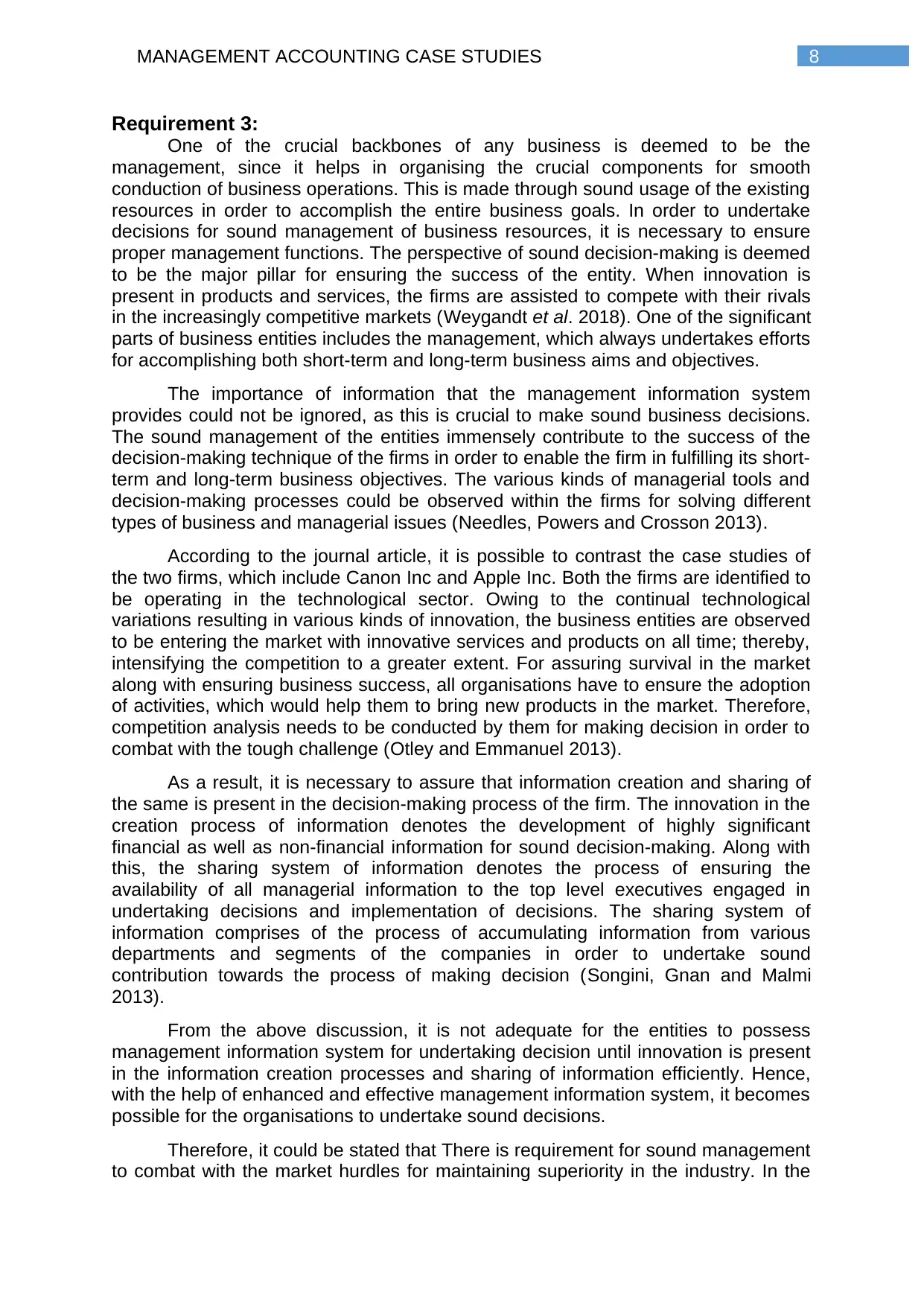
8MANAGEMENT ACCOUNTING CASE STUDIES
Requirement 3:
One of the crucial backbones of any business is deemed to be the
management, since it helps in organising the crucial components for smooth
conduction of business operations. This is made through sound usage of the existing
resources in order to accomplish the entire business goals. In order to undertake
decisions for sound management of business resources, it is necessary to ensure
proper management functions. The perspective of sound decision-making is deemed
to be the major pillar for ensuring the success of the entity. When innovation is
present in products and services, the firms are assisted to compete with their rivals
in the increasingly competitive markets (Weygandt et al. 2018). One of the significant
parts of business entities includes the management, which always undertakes efforts
for accomplishing both short-term and long-term business aims and objectives.
The importance of information that the management information system
provides could not be ignored, as this is crucial to make sound business decisions.
The sound management of the entities immensely contribute to the success of the
decision-making technique of the firms in order to enable the firm in fulfilling its short-
term and long-term business objectives. The various kinds of managerial tools and
decision-making processes could be observed within the firms for solving different
types of business and managerial issues (Needles, Powers and Crosson 2013).
According to the journal article, it is possible to contrast the case studies of
the two firms, which include Canon Inc and Apple Inc. Both the firms are identified to
be operating in the technological sector. Owing to the continual technological
variations resulting in various kinds of innovation, the business entities are observed
to be entering the market with innovative services and products on all time; thereby,
intensifying the competition to a greater extent. For assuring survival in the market
along with ensuring business success, all organisations have to ensure the adoption
of activities, which would help them to bring new products in the market. Therefore,
competition analysis needs to be conducted by them for making decision in order to
combat with the tough challenge (Otley and Emmanuel 2013).
As a result, it is necessary to assure that information creation and sharing of
the same is present in the decision-making process of the firm. The innovation in the
creation process of information denotes the development of highly significant
financial as well as non-financial information for sound decision-making. Along with
this, the sharing system of information denotes the process of ensuring the
availability of all managerial information to the top level executives engaged in
undertaking decisions and implementation of decisions. The sharing system of
information comprises of the process of accumulating information from various
departments and segments of the companies in order to undertake sound
contribution towards the process of making decision (Songini, Gnan and Malmi
2013).
From the above discussion, it is not adequate for the entities to possess
management information system for undertaking decision until innovation is present
in the information creation processes and sharing of information efficiently. Hence,
with the help of enhanced and effective management information system, it becomes
possible for the organisations to undertake sound decisions.
Therefore, it could be stated that There is requirement for sound management
to combat with the market hurdles for maintaining superiority in the industry. In the
Requirement 3:
One of the crucial backbones of any business is deemed to be the
management, since it helps in organising the crucial components for smooth
conduction of business operations. This is made through sound usage of the existing
resources in order to accomplish the entire business goals. In order to undertake
decisions for sound management of business resources, it is necessary to ensure
proper management functions. The perspective of sound decision-making is deemed
to be the major pillar for ensuring the success of the entity. When innovation is
present in products and services, the firms are assisted to compete with their rivals
in the increasingly competitive markets (Weygandt et al. 2018). One of the significant
parts of business entities includes the management, which always undertakes efforts
for accomplishing both short-term and long-term business aims and objectives.
The importance of information that the management information system
provides could not be ignored, as this is crucial to make sound business decisions.
The sound management of the entities immensely contribute to the success of the
decision-making technique of the firms in order to enable the firm in fulfilling its short-
term and long-term business objectives. The various kinds of managerial tools and
decision-making processes could be observed within the firms for solving different
types of business and managerial issues (Needles, Powers and Crosson 2013).
According to the journal article, it is possible to contrast the case studies of
the two firms, which include Canon Inc and Apple Inc. Both the firms are identified to
be operating in the technological sector. Owing to the continual technological
variations resulting in various kinds of innovation, the business entities are observed
to be entering the market with innovative services and products on all time; thereby,
intensifying the competition to a greater extent. For assuring survival in the market
along with ensuring business success, all organisations have to ensure the adoption
of activities, which would help them to bring new products in the market. Therefore,
competition analysis needs to be conducted by them for making decision in order to
combat with the tough challenge (Otley and Emmanuel 2013).
As a result, it is necessary to assure that information creation and sharing of
the same is present in the decision-making process of the firm. The innovation in the
creation process of information denotes the development of highly significant
financial as well as non-financial information for sound decision-making. Along with
this, the sharing system of information denotes the process of ensuring the
availability of all managerial information to the top level executives engaged in
undertaking decisions and implementation of decisions. The sharing system of
information comprises of the process of accumulating information from various
departments and segments of the companies in order to undertake sound
contribution towards the process of making decision (Songini, Gnan and Malmi
2013).
From the above discussion, it is not adequate for the entities to possess
management information system for undertaking decision until innovation is present
in the information creation processes and sharing of information efficiently. Hence,
with the help of enhanced and effective management information system, it becomes
possible for the organisations to undertake sound decisions.
Therefore, it could be stated that There is requirement for sound management
to combat with the market hurdles for maintaining superiority in the industry. In the
⊘ This is a preview!⊘
Do you want full access?
Subscribe today to unlock all pages.

Trusted by 1+ million students worldwide
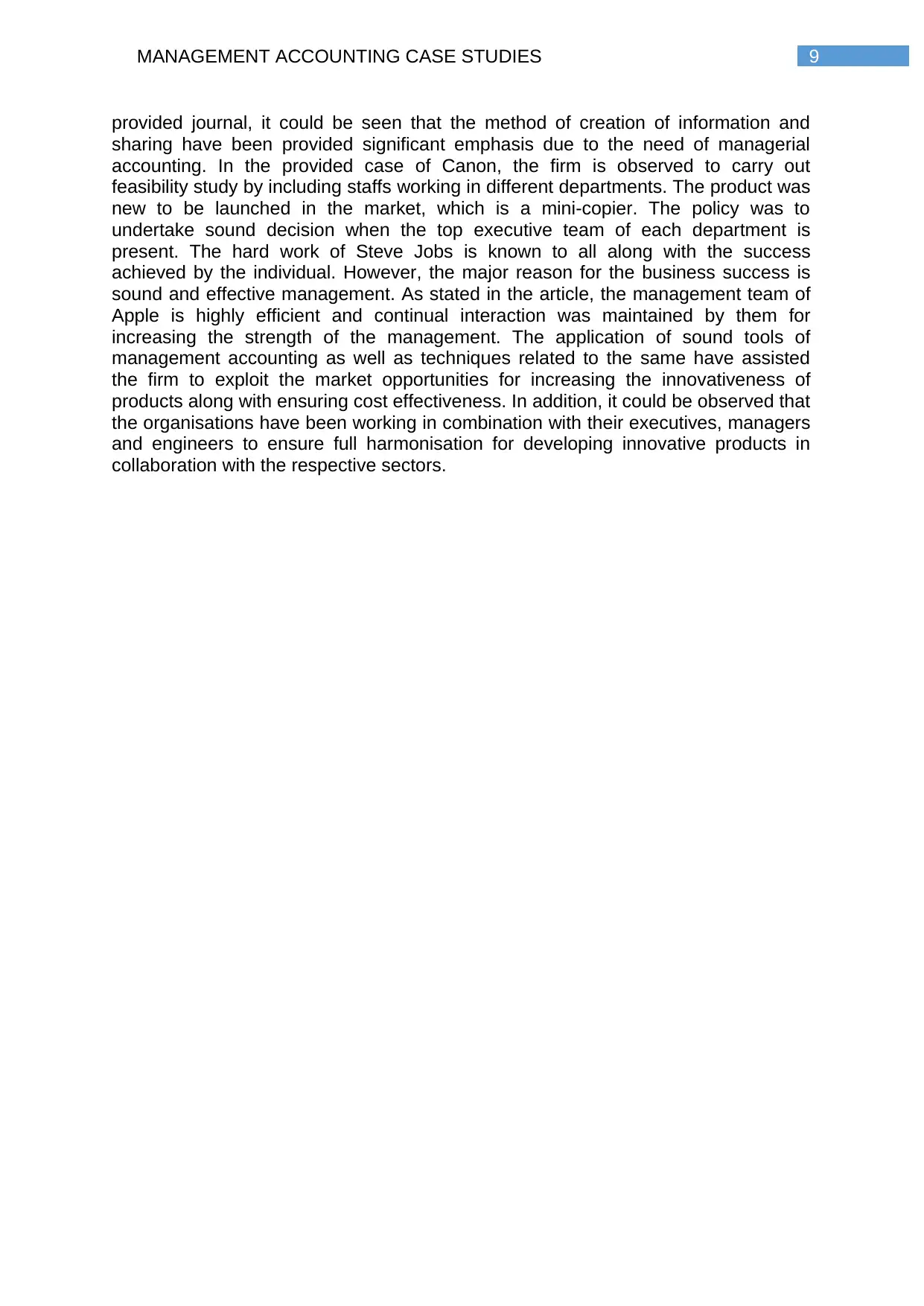
9MANAGEMENT ACCOUNTING CASE STUDIES
provided journal, it could be seen that the method of creation of information and
sharing have been provided significant emphasis due to the need of managerial
accounting. In the provided case of Canon, the firm is observed to carry out
feasibility study by including staffs working in different departments. The product was
new to be launched in the market, which is a mini-copier. The policy was to
undertake sound decision when the top executive team of each department is
present. The hard work of Steve Jobs is known to all along with the success
achieved by the individual. However, the major reason for the business success is
sound and effective management. As stated in the article, the management team of
Apple is highly efficient and continual interaction was maintained by them for
increasing the strength of the management. The application of sound tools of
management accounting as well as techniques related to the same have assisted
the firm to exploit the market opportunities for increasing the innovativeness of
products along with ensuring cost effectiveness. In addition, it could be observed that
the organisations have been working in combination with their executives, managers
and engineers to ensure full harmonisation for developing innovative products in
collaboration with the respective sectors.
provided journal, it could be seen that the method of creation of information and
sharing have been provided significant emphasis due to the need of managerial
accounting. In the provided case of Canon, the firm is observed to carry out
feasibility study by including staffs working in different departments. The product was
new to be launched in the market, which is a mini-copier. The policy was to
undertake sound decision when the top executive team of each department is
present. The hard work of Steve Jobs is known to all along with the success
achieved by the individual. However, the major reason for the business success is
sound and effective management. As stated in the article, the management team of
Apple is highly efficient and continual interaction was maintained by them for
increasing the strength of the management. The application of sound tools of
management accounting as well as techniques related to the same have assisted
the firm to exploit the market opportunities for increasing the innovativeness of
products along with ensuring cost effectiveness. In addition, it could be observed that
the organisations have been working in combination with their executives, managers
and engineers to ensure full harmonisation for developing innovative products in
collaboration with the respective sectors.
Paraphrase This Document
Need a fresh take? Get an instant paraphrase of this document with our AI Paraphraser

10MANAGEMENT ACCOUNTING CASE STUDIES
References:
Lavia López, O. and Hiebl, M.R., 2014. Management accounting in small and
medium-sized enterprises: current knowledge and avenues for further
research. Journal of Management Accounting Research, 27(1), pp.81-119.
Fullerton, R.R., Kennedy, F.A. and Widener, S.K., 2014. Lean manufacturing and
firm performance: The incremental contribution of lean management accounting
practices. Journal of Operations Management, 32(7-8), pp.414-428.
Krstevski, D. and Mancheski, G., 2016. Managerial accounting: Modeling customer
lifetime value-An application in the telecommunication industry. European Journal of
Business and Social Sciences, 5(01), pp.64-77.
Mihăilă, M., 2014. Managerial accounting and decision making, in energy
industry. Procedia-Social and Behavioral Sciences, 109, pp.1199-1202.
Narayanaswamy, R., 2017. Financial accounting: a managerial perspective. PHI
Learning Pvt. Ltd..
Needles, B. and Crosson, S., 2013. Managerial accounting. Cengage Learning.
Needles, B.E., Powers, M. and Crosson, S.V., 2013. Financial and managerial
accounting. Nelson Education.
Nonala, I. and Kenney, M., 1991. Towards a new theory of innovation management:
A case study comparing Canon, Inc. and Apple Computer, Inc. Journal of
Engineering and Technology Management, 8(1), pp.67-83.
Otley, D. and Emmanuel, K.M.C., 2013. Readings in accounting for management
control. Springer.
Songini, L., Gnan, L. and Malmi, T., 2013. The role and impact of accounting in
family business. Journal of Family Business Strategy, 4(2), pp.71-83.
Warren, C., Reeve, J.M. and Duchac, J., 2013. Financial & managerial accounting.
Cengage Learning.
Weygandt, J.J., Kieso, D.E., Kimmel, P.D. and Aly, I.M., 2018. Managerial
Accounting: Tools for Business Decision-making. John Wiley & Sons Canada,
Limited.
References:
Lavia López, O. and Hiebl, M.R., 2014. Management accounting in small and
medium-sized enterprises: current knowledge and avenues for further
research. Journal of Management Accounting Research, 27(1), pp.81-119.
Fullerton, R.R., Kennedy, F.A. and Widener, S.K., 2014. Lean manufacturing and
firm performance: The incremental contribution of lean management accounting
practices. Journal of Operations Management, 32(7-8), pp.414-428.
Krstevski, D. and Mancheski, G., 2016. Managerial accounting: Modeling customer
lifetime value-An application in the telecommunication industry. European Journal of
Business and Social Sciences, 5(01), pp.64-77.
Mihăilă, M., 2014. Managerial accounting and decision making, in energy
industry. Procedia-Social and Behavioral Sciences, 109, pp.1199-1202.
Narayanaswamy, R., 2017. Financial accounting: a managerial perspective. PHI
Learning Pvt. Ltd..
Needles, B. and Crosson, S., 2013. Managerial accounting. Cengage Learning.
Needles, B.E., Powers, M. and Crosson, S.V., 2013. Financial and managerial
accounting. Nelson Education.
Nonala, I. and Kenney, M., 1991. Towards a new theory of innovation management:
A case study comparing Canon, Inc. and Apple Computer, Inc. Journal of
Engineering and Technology Management, 8(1), pp.67-83.
Otley, D. and Emmanuel, K.M.C., 2013. Readings in accounting for management
control. Springer.
Songini, L., Gnan, L. and Malmi, T., 2013. The role and impact of accounting in
family business. Journal of Family Business Strategy, 4(2), pp.71-83.
Warren, C., Reeve, J.M. and Duchac, J., 2013. Financial & managerial accounting.
Cengage Learning.
Weygandt, J.J., Kieso, D.E., Kimmel, P.D. and Aly, I.M., 2018. Managerial
Accounting: Tools for Business Decision-making. John Wiley & Sons Canada,
Limited.
1 out of 11
Related Documents
Your All-in-One AI-Powered Toolkit for Academic Success.
+13062052269
info@desklib.com
Available 24*7 on WhatsApp / Email
![[object Object]](/_next/static/media/star-bottom.7253800d.svg)
Unlock your academic potential
Copyright © 2020–2025 A2Z Services. All Rights Reserved. Developed and managed by ZUCOL.





